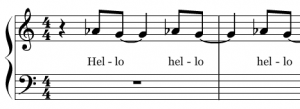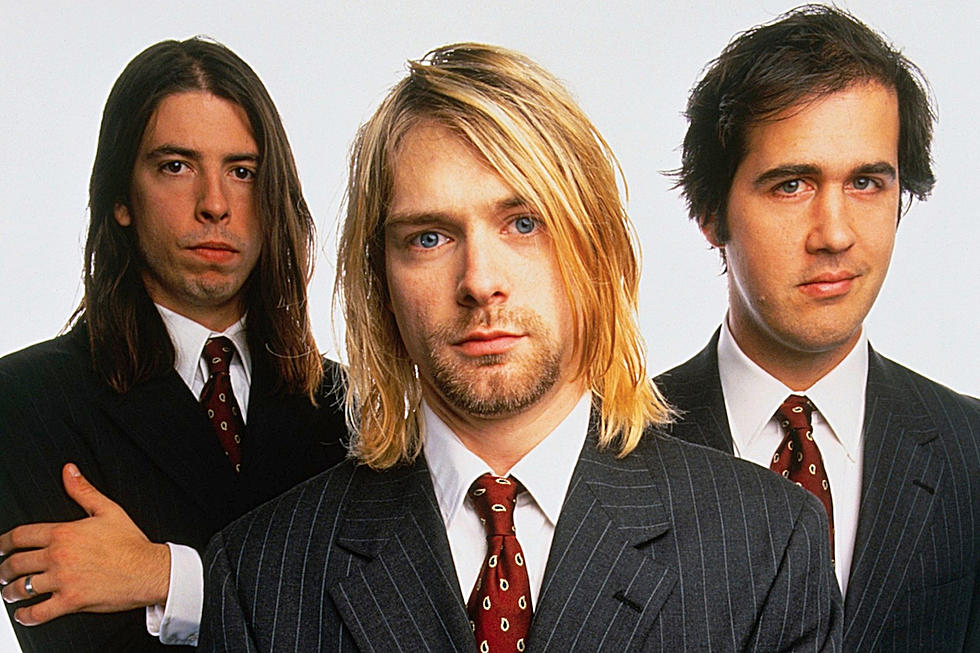What makes a song iconic? UK researcher thinks he found the answer (Do you agree?)
With the help of his computer software, Dr. Mick Grierson set out to find the most iconic song of all time. What he found may surprise you…
By Dale McGowan from Soundfly
A University of London researcher has found something we didn’t even know we were looking for: the most iconic song ever written. After announcing his choice, he was moved to an undisclosed location.
If the comment sections are any indication, a lot of the complaints are due to a misunderstanding about the researcher’s claim. He didn’t claim to have found the best song, or the most powerful, moving, or effective one. Dr. Mick Grierson was looking for the most iconic.
To qualify as iconic, he says, a song has to be well-known and distinctive. If it’s famous but very similar to a lot of others, it isn’t distinctive, so it can’t really be iconic. And a very distinctive song still isn’t iconic if few people have ever heard it. It might be to you, but not to the culture at large.
Even understanding that, I was mystified by the result — until I discovered something hiding in plain sight.
Grierson created a credible list of the 50 best-known songs using lists from magazines like Rolling Stone. To assess “distinctiveness,” he used computer software to analyze some elements of the music itself. Of the 50 songs:
- 80% are in a major key (mostly A, E, C and G)
- Average tempo is 125 beats per minute, a brisk walking tempo
- Average length is 4 minutes on the nose
- Average number of different chords is 6-8 chords
He also looked at something he called “spectral flux,” which he said is “how the power of a note from one to the next varies.” I’m not sure what he means by that, but I’m guessing it has to do with variation in tone color and intensity.
Another variable called “tonic dissonance” apparently refers to the use of pitches outside of the key (i.e. non-harmonic tones).
So what he wanted was a song that was famous but departed from the norm in a number of these quantifiable ways. A minor key would count as departure, as would unusual tempo or length, or greater than average number of chord changes, or frequent changes of timbre, or a lot of pitches outside of the key.
So what song did he and his computer decide is the most iconic of all time? Nirvana’s1991 hit “Smells Like Teen Spirit.”
I…wut?
I’m not one to howl when the particular headbanger anthem that got me through puberty doesn’t make somebody’s Top Ten list. I’m on the side of truth and justice for this one, no skin in the game. In fact, I really like “Teen Spirit,” especially the way the melody leans into unexpected pitches, and that contrast between quiet lethargy and full-throated entitlement. More emblematic of a generational moment than most songs making that claim. I can even see it in the Top 50 iconics, why not.
But by the study’s own stated variables — not just my preferences — I couldn’t understand how it qualified as Most Iconic. Let’s compare “Teen Spirit” to two other songs that were lower on the list.
#1. Nirvana – “Smells Like Teen Spirit” (1991)
Most of the top 50 are in a major key, and “Teen Spirit” is minor. One point for iconic. The tempo is 116 beats a minute, close to the average of 125 BPM. The length is 4:35, just over the average of 4:00. Two points for typical.
Harmonic diversity is slim. Aside from the kind of silly 4-bar bridges at 1:23 and 2:38, the whole song appears to be the same four chords in the same order: F minor, B♭, A♭, and D♭.
Hey wait a sec: they aren’t even chords. Chords have at least three pitches. These are something guitarists call “power chords,” a rock staple (i.e. “not iconic”) that removes the third from every chord. So instead of F-A♭-C, it’s just F-C, and so on. It’s a really powerful, raw sound, but it reduces the already poor pitch diversity even further.
If we take out the little 4-bar bridges — a total of 16 seconds — “Teen Spirit” doesn’t have even one pitch outside of the key, which is pretty low tonic dissonance. Include the bridges and it has just two such pitches.
Variation in timbre is there, but moderate. An effective toggle of atmospheres between the mumble and shout sections, but it’s still drums and guitars from start to finish.
I love the song, and it’s Top 50 iconic. But not #1.
#15. Led Zeppelin – “Stairway to Heaven” (1971)
Despite a minor key, a distinctive harmonic language, a rhapsodic structure, and an 8-minute duration (for which I and all other teenage slow-dancers of the 1970s and ’80s are grateful), this iconic rock song came in 15th.
Within seven seconds, “Stairway” has already exceeded “Teen Spirit” in harmonic variety. It starts with a progression of five different chords over that (yes) iconic chromatic bass line, including an augmented triad and a major-major 7th chord on VI.
Tempo structure is also unique. It starts at 76 BPM, way off the average. When the drums enter for the first time at 4:19…well, first of all you say, “No drums for four minutes and 19 seconds! How iconic!” Then the tempo picks up a click to 84 BPM. Around 6 minutes, it goes up to 96. It’s a nice effect, a slight acceleration over time that helps sustain the long form.
As for tone color, dynamics, and other “spectral” aspects, “Stairway” moves through multiple sections, from acoustic guitar and a consort of recorders (iconic!) to electric guitars and a shout chorus before ending in a quiet solo a cappella.
Finally, did the researcher even try making out to ‘Smells Like Teen Spirit?” You’d end up on a pile of bloody teeth. “Stairway” for the win.
#5. Queen – “Bohemian Rhapsody” (1975)
For pure iconic differentness, it’s “Bohemian Rhapsody” in a walk. A six-part rhapsody form moves from a cappella ballad to Gilbert and Sullivan operetta to hard rock and back to ballad, changing key at every gate.
But we don’t even have to look that far to beat Teen Spirit. In the introduction alone, “Rhapsody” has nine different chords, including an added sixth chord (0:05), a secondary dominant 7th (0:09), chromatic neighbor chords (0:37), and a fully-diminished secondary leading tone 7th chord (0:47). AND it changes key after just 25 seconds.
Talk about awesome tonic dissonance — all that, and all 12 notes of the chromatic scale, and we’re less than one minute in.
But wait a minute.
The pretty obvious thing I missed about “Teen Spirit.”
There’s another chord in “Teen Spirit.” It doesn’t show up in the chord charts, and it has always slipped right past my ear. It’s a chromatic passing chord, the very last thing you hear at the end of the first bar.

Tiny detail, right? It is to us humans. But here’s the thing: We’re in F minor, so both of those notes (E and A) are outside of the key. And it appears not once, but about fifty times, in alternating bars for most of the song! To you and me, it slides on by. But a computer analyzing for pitch variety will hear a song positively soaking in “tonic dissonance.”
Still, that’s only eight notes out of 12. We’re still missing G♭, G, B and D.
But wait! What about those two ugly notes in the bridge?

Dude, no way! It’s G♭ and B. Add the excellent G Kurt is always leaning on and “Smells Like Teen Spirit” has 11 of the 12 chromatic pitches, including a constant saturation of those two pitches outside of the key.

But here’s the thing: Except for the vocal G, they just aren’t significant. Unlike “Bohemian Rhapsody,” for example, the unusual pitches are mostly incidental — a passing tone on a weak beat. No matter how often it happens, it isn’t significant enough to raise a song to iconic status. Our brains can sort between significant pitches and incidental ones. But to a computer counting the frequency of frequencies, it’s all the same.
That’s why “Smells Like Teen Spirit” is the #1 most iconic song among Dell Inspirons.

The 50 Most Iconic Songs (according to a computer.)
1. “Smells Like Teen Spirit,” Nirvana
2. “Imagine,” John Lennon
3. “One,” U2
4. “Billie Jean,” Michael Jackson
5. “Bohemian Rhapsody,” Queen
6. “Hey Jude,” The Beatles
7. “Like A Rolling Stone,” Bob Dylan
8. “I Can’t Get No Satisfaction,” Rolling Stones
9. “God Save The Queen,” Sex Pistols
10. “Sweet Child O’ Mine,” Guns N’ Roses
11. “London Calling,” The Clash
12. “Waterloo Sunset,” The Kinks
13. “Hotel California,” The Eagles
14. “Your Song,” Elton John
15. “Stairway To Heaven,” Led Zeppelin
16. “The Twist,” Chubby Checker
17. “Live Forever,” Oasis
18. “I Will Always Love You,” Whitney Houston
19. “Life On Mars?” David Bowie
20. “Heartbreak Hotel,” Elvis Presley
21. “Over The Rainbow,” Judy Garland
22. “What’s Goin’ On,” Marvin Gaye
23. “Born To Run,” Bruce Springsteen
24. “Be My Baby,” The Ronettes
25. “Creep,” Radiohead
26. “Bridge Over Troubled Water,” Simon & Garfunkel
27. “Respect,” Aretha Franklin
28. “Family Affair,” Sly And The Family Stone
29. “Dancing Queen,” ABBA
30. “Good Vibrations,” The Beach Boys
31. “Purple Haze,” Jimi Hendrix
32. “Yesterday,” The Beatles
33. “Jonny B Goode,” Chuck Berry
34. “No Woman No Cry,” Bob Marley
35. “Hallelujah,” Jeff Buckley
36. “Every Breath You Take,” The Police
37. “A Day In The Life,” The Beatles
38. “Stand By Me,” Ben E King
39. “Papa’s Got A Brand New Bag,” James Brown
40. “Gimme Shelter,” The Rolling Stones
41. “What’d I Say,” Ray Charles
42. “Sultans Of Swing,” Dire Straits
43. “God Only Knows,” The Beach Boys
44. “You’ve Lost That Lovin’ Feeling,” The Righteous Brothers
45. “My Generation,” The Who
46. “Dancing In The Street,” Martha Reeves and the Vandellas
47. “When Doves Cry,” Prince
48. “A Change Is Gonna Come,” Sam Cooke
49. “River Deep Mountain High,” Ike and Tina Turner
50. “Best Of My Love,” The Emotions
—
Dale McGowan has one foot in arts, the other in sciences, and the other in nonreligious life. He double-majored in music and evolutionary anthropology at UC Berkeley, then studied film scoring at UCLA before conducting a college orchestra while earning a Ph.D. in Composition from the University of Minnesota. Dale is managing editor of nonreligious writers at Patheos, the world’s largest website for multi-belief opinion. He teaches music at Oglethorpe University, is at work on a book about how music communicates emotion, and hosts the How Music Does That podcast.
